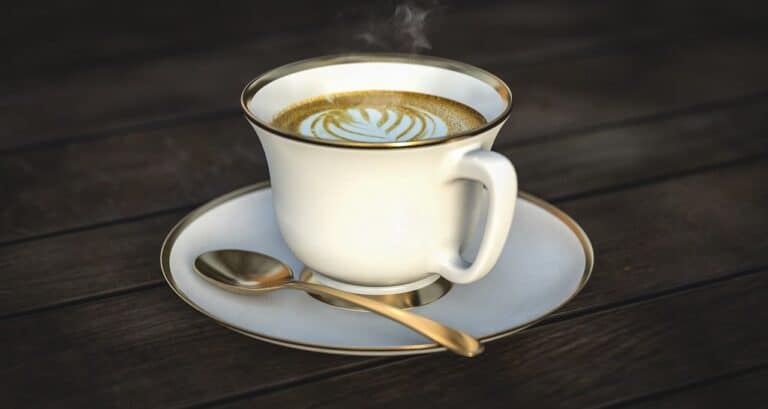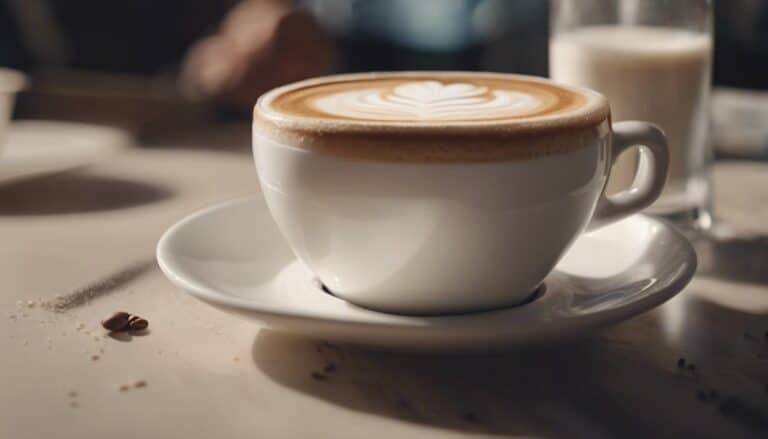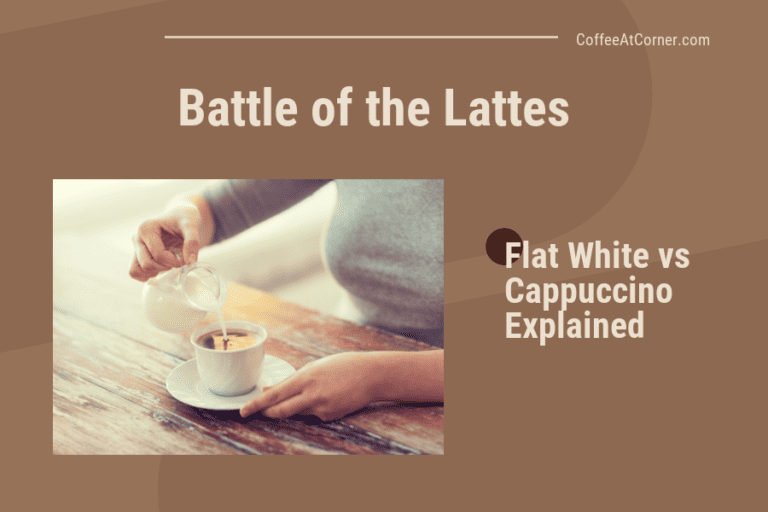10 Key Differences Between Cappuccino and Latte You Need to Know

As we dip our spoons into the world of espresso-based delights, picture the velvety swirls of frothed milk cascading down a steaming cup, promising a delightful burst of flavors.
But have you ever paused to ponder the subtle nuances that set a cappuccino apart from a latte? These iconic caffeinated concoctions hold secrets in their layers, waiting to be unraveled.
Join us as we explore the intricacies that make each sip a journey of taste and texture, revealing the distinct character of these beloved beverages.
Milk Ratio
Have you ever wondered how the milk ratio differs between a cappuccino and a latte? Well, let's dive into the world of coffee drinks to uncover the delicious details!
In a cappuccino, the milk ratio plays a crucial role in defining its unique taste and texture. This classic coffee beverage consists of equal parts espresso, steamed milk, and frothed milk, creating a beautifully layered drink. The balance between the rich espresso and the creamy milk, with just the right amount of foam, gives the cappuccino its bold flavor profile.
On the other hand, a latte boasts a higher milk ratio, making it a smoother and creamier option compared to the cappuccino. With more steamed milk and just a light layer of foam on top, lattes offer a milder coffee experience that's beloved by many. The milk in a latte acts as a perfect complement to the espresso, resulting in a well-rounded and comforting drink that coffee enthusiasts adore.
Understanding the milk ratio distinction between these two popular coffee drinks is essential for choosing the perfect brew to suit your preferences.
Foam Texture
What distinguishes the foam texture between a cappuccino and a latte, and how does it impact the overall coffee experience?
The foam texture is a key factor that sets these two popular coffee drinks apart. In a cappuccino, you'll find a thick and dense foam that sits beautifully atop the espresso. This thick foam not only adds a visual appeal but also contributes to the bold and rich mouthfeel that cappuccinos are known for.
On the other hand, a latte boasts a lighter and less prominent foam. The light foam in a latte plays a different role, offering a more subtle addition that enhances the smooth texture of the drink.
These texture differences in the foam are crucial in defining the overall experience of enjoying a cappuccino versus a latte. Whether you prefer the luxurious thickness of cappuccino foam or the delicate touch of latte foam, the foam texture undoubtedly plays a significant role in distinguishing between these two classic coffee beverages.
Espresso Strength
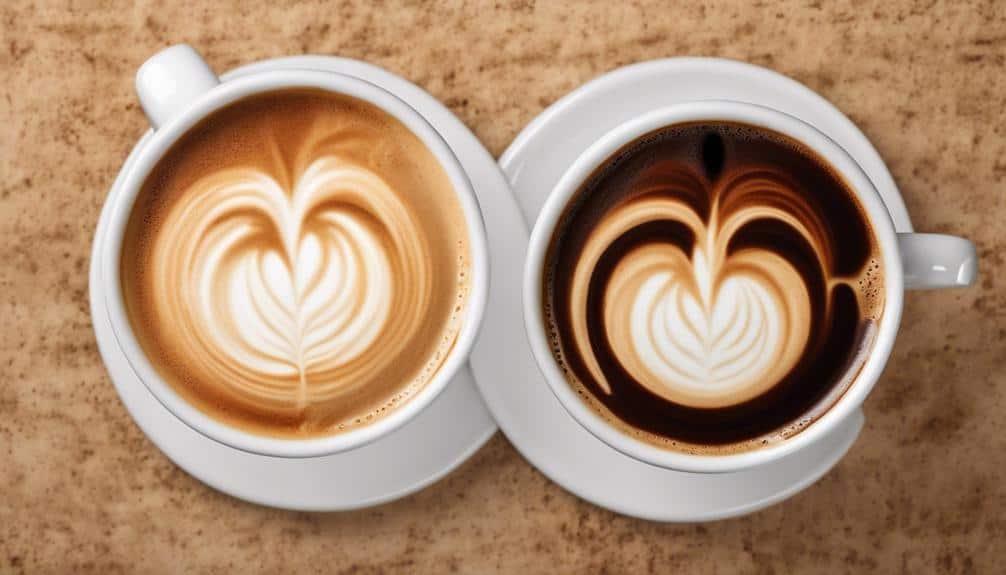
Exuding a robust and invigorating essence, the espresso strength in both cappuccinos and lattes plays a pivotal role in shaping their distinct flavor profiles and overall coffee experience. In a cappuccino, the strength is achieved through the perfect harmony of equal parts espresso, steamed milk, and milk foam. The balance between the intense espresso and velvety foam creates a bold and rich flavor that's unique to this classic drink. The froth in cappuccinos not only adds to its strength but also contributes to its luxurious texture and visual appeal.
On the other hand, lattes have a milder taste compared to cappuccinos due to their higher ratio of steamed milk. Despite containing the same amount of espresso as cappuccinos, the dominance of steamed milk in lattes results in a smoother and creamier flavor profile. The espresso in lattes provides a subtle kick, enhancing the overall experience without overpowering the drink with its strength. Whether you prefer the robust intensity of a cappuccino or the creamy softness of a latte, the espresso strength in each brew guarantees a delightful coffee indulgence.
Serving Size
When it comes to cappuccinos and lattes, the serving size plays a significant role in the coffee experience.
The difference in cup size affects the milk to espresso ratio and foam texture, ultimately influencing the overall taste.
Understanding these variations can help coffee lovers choose the perfect drink to suit their preferences.
Cup Size Difference
Uniquely highlighting the contrast in cup sizes between cappuccinos and lattes, the serving size plays a pivotal role in defining the essence of each coffee drink. Here are some key points to consider:
- Cappuccinos are typically served in smaller cups, usually around 5 to 6 ounces, allowing the rich espresso flavor to shine through.
- Lattes, on the other hand, come in larger cups ranging from 8 to 12 ounces, providing a more substantial drink with the creamy texture of steamed milk.
- The smaller portion size of a cappuccino emphasizes the boldness of the espresso, creating a strong and intense coffee experience.
- Lattes offer a larger serving size to balance the espresso with a smooth and velvety milk component, offering a more mellow and comforting drink.
Milk to Espresso Ratio
In a cappuccino, the milk to espresso ratio typically maintains a 1:1:1 balance, resulting in a smaller serving size that accentuates the bold flavors of the espresso. This precise ratio ensures that each sip delivers a harmonious blend of rich espresso, velvety steamed milk, and airy milk foam.
The smaller serving size of a cappuccino allows you to savor the intense coffee notes without being overwhelmed by the milk content. In contrast, lattes have a higher milk-to-espresso ratio, usually around 2:1, leading to a larger portion size that offers a creamier and milder coffee experience.
Understanding the milk to espresso ratio in these espresso drinks is key to choosing the serving size that best suits your preference for a bolder or creamier coffee indulgence.
Foam Texture Variation
With cappuccino boasting a thicker, heavier foam texture compared to latte, the serving size of these espresso beverages varies to accommodate their distinct foam compositions. Here's why this matters:
- Foam Thickness: The dense foam in cappuccinos requires less volume in the cup.
- Mouthfeel Contrast: Latte's lighter foam contributes to a smoother texture.
- Strength Factor: Cappuccino's foam enhances its robust espresso flavor.
- Flavor Emphasis: Latte's subtle foam allows the espresso notes to shine through.
Understanding the foam texture differences between cappuccino and latte not only impacts the serving size but also influences the overall taste experience. Whether you prefer a velvety latte or a bold cappuccino, the foam texture plays a crucial role in defining your espresso moment.
Layering Technique
When crafting a cappuccino or latte, the layering technique plays a crucial role in defining the visual presentation and flavor experience of each espresso-based drink. Cappuccinos are known for their distinct layering of equal parts of espresso, steamed milk, and milk foam, creating a visually appealing drink with three well-defined layers. On the other hand, lattes are not layered like cappuccinos; the espresso is combined with steamed milk and a light layer of foam on top, resulting in a more blended appearance.
To better illustrate the difference in layering between cappuccinos and lattes, let's take a look at the table below:
| Layer | Cappuccino | Latte |
|---|---|---|
| Bottom | Espresso | Espresso |
| Middle | Steamed Milk | Steamed Milk |
| Top | Milk Foam | Light Foam |
This side-by-side comparison highlights how the layering technique impacts the visual appeal of these two beloved espresso beverages.
Taste Profile

Moving from the layering technique to the taste profile, we can explore how the distinct milk-to-espresso ratio in cappuccinos and lattes shapes their flavor experiences.
- Boldness: Cappuccinos boast a bold flavor profile as they contain less steamed milk and more foam, allowing the rich espresso to shine through.
- Creaminess: Lattes, on the other hand, offer a milder taste with a creamy texture derived from a higher ratio of steamed milk, creating a smoother drinking experience.
- Espresso Intensity: Cappuccinos are known for their strong espresso taste, making them a go-to choice for those who enjoy the robust flavor of espresso.
- Customization: Lattes provide a canvas for flavor experimentation, allowing for the addition of syrups like vanilla, mocha, or caramel to create a sweeter and more personalized flavor profile.
The interplay between espresso, steamed milk, foam, and flavor in cappuccinos and lattes offers a diverse range of taste experiences, catering to different preferences and palates.
Origin Stories
Originating in Italy, the captivating tale behind the creation of cappuccino intertwines with the traditions of the Capuchin friars. The name 'cappuccino' finds its roots in the friars' distinctive brown robes, resembling the color of the coffee mixed with frothy milk. This iconic beverage emerged in the early 20th century, evolving from the traditional Italian espresso.
On the other hand, the latte, deriving its name from the Italian word for milk, has a more modern history. Caffè latte was first introduced by Lino Meiorin in Berkeley, California, adding a new chapter to the world of coffee.
Italian journeys and influences paved the way for these beloved drinks to reach global fame. From the cobbled streets of Rome to the bustling cafes of Milan, the aroma of freshly brewed cappuccinos and lattes has enchanted many. The tales of their origins, intertwined with the rich history of coffee culture, continue to captivate enthusiasts worldwide. Even the renowned American author William Dean Howells expressed his fondness for the Italian coffee scene, further immortalizing the allure of cappuccino and latte in the hearts of many.
Popular Variations

Delving into the realm of coffee indulgence, our exploration of popular variations unveils a spectrum of creative twists on the classic cappuccino and latte. Here are four popular variations that add a delightful twist to your coffee experience:
- Matcha Latte: This trendy variation combines the earthy flavors of matcha powder with the creamy goodness of steamed milk, creating a vibrant green drink packed with antioxidants.
- Mocha Latte: Indulge in a rich and decadent treat by blending espresso, steamed milk, and chocolate syrup. The mocha latte offers a perfect balance of bitterness and sweetness in every sip.
- Flat White: Hailing from Australia, the flat white is renowned for its velvety microfoam texture that beautifully complements the strong espresso, resulting in a smooth and satisfying coffee experience.
- Cortado: For those who prefer a bolder flavor profile, the cortado mixes equal parts of espresso and steamed milk, creating a small yet potent coffee beverage that's both rich and smooth.
Brewing Methods
When we explore the brewing methods of cappuccino and latte, we uncover the intricate processes that result in distinct flavor profiles and textures for these beloved coffee drinks.
Cappuccino, traditionally made with equal parts espresso, steamed milk, and milk foam, showcases a layered presentation that balances the strong espresso with the velvety steamed milk and airy foam. This method creates a bold flavor profile with a rich and creamy texture that delights the taste buds.
On the other hand, latte is brewed with a higher ratio of steamed milk to espresso, resulting in a smoother and creamier texture, topped with a light layer of foam. The emphasis here is on creating a velvety drink with a subtle espresso taste that's perfect for those who prefer a milder coffee experience.
Understanding these distinct brewing methods is essential for appreciating the unique taste, texture, and overall experience that each coffee variant offers.
Latte Art Styles
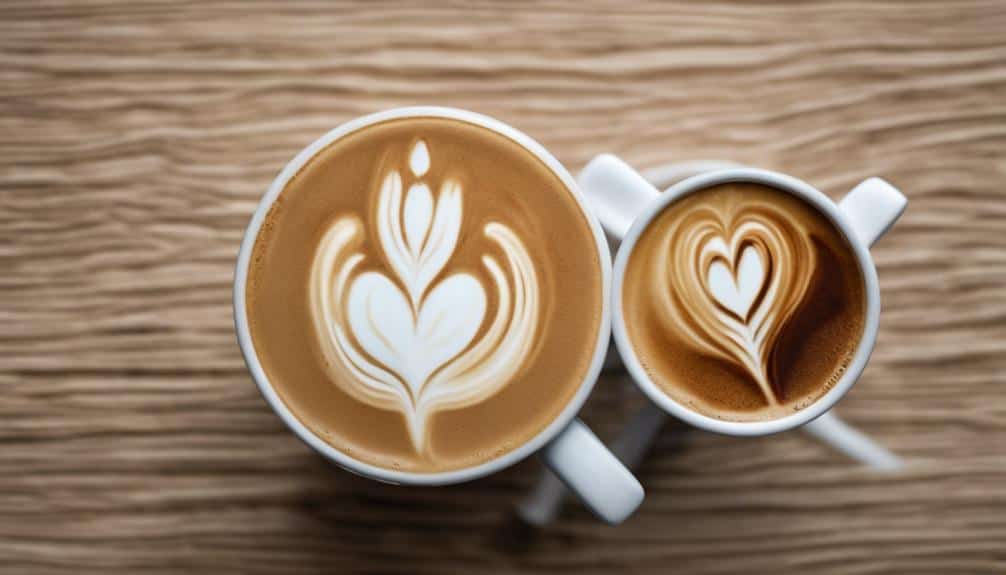
Let's talk about the exciting world of latte art styles!
From classic hearts and rosettas to intricate swans and tulips, there's a whole array of designs to explore.
Baristas' skills shine as they master milk frothing techniques to craft visually stunning patterns like ferns, tulips, and even phoenixes.
It's amazing how a simple touch of artistry can transform a regular latte into a masterpiece worth savoring!
Popular Latte Art
Exploring the artistry of latte making unveils a captivating array of popular latte art styles that adorn this beloved coffee beverage. Here are some popular latte art styles that showcase the creativity and skill of baristas:
- Heart: A classic design symbolizing love and care, created by pouring steamed milk into espresso in a way that forms a heart shape.
- Rosetta: This intricate fern-like pattern is achieved by skillfully layering milk on top of espresso, requiring precision and control over milk frothing.
- Tulip: A beautiful floral design that involves pouring milk into espresso in a way that creates overlapping layers resembling tulip petals.
- Swan: A more advanced latte art style that entails shaping the milk into a swan-like figure through precise pouring techniques and intricate movements.
These popular latte art styles not only enhance the visual appeal of a latte but also reflect the dedication and expertise of the barista.
Mastering Milk Frothing
As we delve into the art of mastering milk frothing for latte art styles, baristas meticulously perfect their techniques to achieve intricate designs that elevate the visual appeal of a latte.
Different latte art styles such as the heart, rosetta, tulip, and swan designs require precise milk frothing techniques like microfoam creation.
The key to successful latte art lies in steaming the milk to the ideal temperature of around 140°F, ensuring the perfect texture and consistency for creating beautiful designs.
Baristas utilize specialized steam wands to froth the milk, creating a velvety microfoam that forms the base for layering the foamed milk and crafting intricate patterns.
Mastering milk frothing is an essential skill that adds an aesthetic touch to the latte, enhancing the overall coffee experience.
Conclusion
In conclusion, understanding the key differences between cappuccinos and lattes can enhance your coffee drinking experience. From the milk ratio to the foam texture and espresso strength, each element contributes to the unique flavors and textures of these beloved beverages.
Whether you prefer the creaminess of a cappuccino or the sweetness of a latte, knowing these distinctions will help you appreciate and savor every sip of your favorite espresso-based drink. Cheers to enjoying the perfect cup of coffee!
